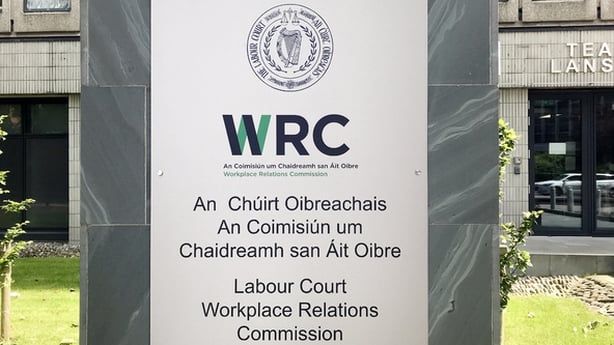Prison Service ageist pay discrimination claims dismissed

Senior officials in the Irish Prison Service who claimed they were being subjected to ageist discrimination because one of their colleagues was earning tens of thousands a year more for similar work have lost their claims at the Workplace Relations Commission.
In equality claims heard last year, two serving directors and one former acting director at the State agency lodged equality claims stating they were entitled to have their six-figure salaries boosted by between €32,000 and €36,000 each to match the €142,892 salary of its former director of care and rehabilitation, Fergal Black.
The State told the WRC Mr Black’s conditions of employment had been “red-circled”.
Operations director Don Culliton, ICT and governance director Donna Creaven, and former acting director of HR Trevor Jordan, each accused the service of ageist pay discrimination in claims under the Employment Equality Act 1998 – with Ms Creaven also claiming her gender was a factor.
The State’s position in all three cases was that the comparator identified, Fergal Black, enjoyed the higher rate of pay on foot of a higher salary sanctioned for the medical director appointed permanently to oversee prisons in 1993.
That salary was then carried through to the incumbent because of hiring pressures during decentralisation in 2007, despite the removal of the requirement for a medical qualification, the tribunal was told.
Mr Culliton said the State’s “red-circling” defence had only emerged shortly before a preliminary hearing in the case early in 2023 and had not been referred to by the Prison Service before.
He said that he, as the prison service’s former HR director, was never aware of such policy.
Former Prison Service director-general Brian Purcell said in evidence that Mr Black’s directorate predated the establishment of the prison service, having been set up in response to a “highly critical” report into prison medical services in the mid-1980s by Dr TK Whitaker.

When the Prison Service’s headquarters were to be decentralised from Dublin to Portlaoise in 2007, the original post-holder – in common with 85% of the agency’s employees – turned down the move and was given a transfer to another public service post.
Longford “wasn’t as attractive” to potential candidates for the directorship, so the absolute requirement for a medical qualification was dropped – allowing for candidates with seven years’ management experience to apply, Mr Purcell said.
Mr Black was ultimately appointed on foot of that competition, the tribunal was told.
Mr Purcell said the premium in pay for the medical directorship reflected the fact that the director had “ultimate responsibility” for prison healthcare and would have to make decisions overruling medical professionals on operational grounds.
Mr Black said in evidence that he was “never” told verbally or in writing that he was being “red-circled” but gave evidence that that he had been made aware at a management meeting that after his retirement, the directorship pay would be reduced to match that of the other directors.
He added that he would have been unlikely to give up his former job as a HSE manager and relocate from Dublin to Longford to take up the position in 2007 if it had not been advertised at the higher rate.
‘Three different stories’
In legal submissions on the cases, which were heard in series on the same day before adjudicator Breiffni O’Neill last September, State counsel Mary-Paula Guinness BL said there was a “clear understanding the role was different” in the past and a need to pay more to attract a satisfactory candidate – describing it as “red-circling”.
A barrister acting for Ms Creavan said the State had given “three different stories” to account for the pay differentials.
“The story that red-circling was in 2018 arising out of the [new clinical director] scenario is the first argument – but there’s no evidence,” Rosemary Mallon said in a legal submission on her client’s case.
“Then the State made a second argument through Mr Purcell, the director general, in 2007; his evidence was that [they] couldn’t get anyone to go to Longford – that is now being put forward as red-circling. Mr Purcell, in fairness to him, says ‘I don’t recall’ and [that] maybe red-circling happened when [the original director] is appointed in the early ’90s,” Ms Mallon added.
“Ms Guinness doesn’t have a client from the Department. Nobody has come along for the Department to say this is when the red-circling happened, and why. Nobody has even produced a red-circling policy. Paper does not refuse ink, particularly with the State – not a shred of paper,” Ms Mallon added.
In response, Ms Guinness said: “I object to Ms Mallon’s description of the State’s case as ‘three different stories’. I find that unprofessional and quite trite.”
Maintaining the terms and conditions of a key role such as the prison service medical director was “exactly what red-circling is about”, Ms Guinness added.
In decisions on the claims published this morning, Mr O’Neill wrote that as the Prison Service accepted the claimants and the medical services director did “like work” for different pay, they had succeeded in raising an inference of discrimination.
However, Mr O’Neill accepted the respondent’s account of how the pay disparity first developed in the 1990s and was preserved due to staffing pressure during decentralisation in 2007, even though the need for a medical qualification was removed.
Mr O’Neill wrote that although Mr Black’s responsibilities had changed since he was first hired, he accepted the Prison Service was “bound by the contractual terms agreed upon at the outset of his employment”.
He found the Prison Service had shown the higher pay for Mr Black was “objectively justified” and that the pay differentials was “attributable to factors other than age”, rejecting all three complaints.





